Saffron milkcap and porcini mushrooms are two examples of ectomycorrhizal mushrooms that form similar relationships with host trees as truffles. They are also both delicious, and so we would like to grow them!
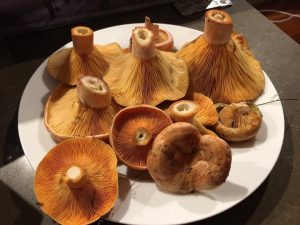
Saffron milkcaps (Lactarius deliciosus) are already growing on a number of mature pine trees on our farm. We are planning to plant a small stand of pine trees as a wind break. Hopefully, we can get these trees to produce large numbers of saffron milkcap mushrooms by inoculating them before planting out!
Since we are running an experiment, we will also include porcini (Boletus edulis) spores in our inoculant, despite the fact that porcini has not yet been successfully cultivated in a plantation.
Both porcini and saffron milkcap mushrooms form mycorrhizal relationships and fruit in association with radiata pine trees (Pinus radiata).
We are adapting techniques outlined in the ACIAR manual “Working with mycorrhizas in forestry and agriculture“.
24 MARCH 2017
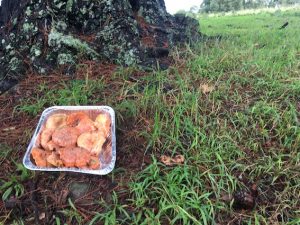
Saffron milkcap mushrooms were collected for use as inoculant, although we ate the best looking and freshest of these mushrooms.
These were very tasty fried with butter, garlic and parsley, tossed with a little parmesan cheese and served on toast.
The rest of the mushrooms went into the freezer until we are ready to try extracting the spores to inoculate our seedlings.
6 NOVEMBER 2017
A tray of Pinus radiata seedlings was germinated using pinecones collected from mature pine trees already growing on our farm. About 41 of the seedlings are standing 4-5cm high, and it looks like a few more might join them in the next few days.

Pinecones were collected in autumn, then heated in a kitchen oven set to 50’C until the scales on the cone started to open (about 60mins). Seeds were then shaken loose and placed in a ziplock bag with a damp paper towel and refrigerated for about six weeks. Seed viability was tested by removing the seed wings, placing the seeds into water and discarding any that floated. The viable seeds were distributed among the 6×8 cells in a seedling tray at about 3-5 seeds per cell.
9 NOVEMBER 2017
A spore suspension was created to apply to the seedlings. Spore slurries are created by “suspending powdered sporocarps in the required volume of water…” [ACIAR manual (pg. 248)]
For this application, we used:
- 30g dried porcini tubes (the “gills” of the dried porcini imported from Macedonia)
- 66g frozen milksap gills
- 400ml water
- a few drops of detergent (Dynamo washing liquid)
These were mixed in a blender, and the slurry then passed through cheesecloth.

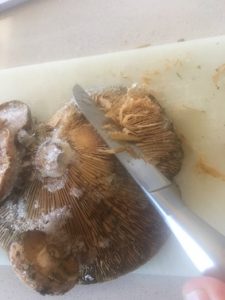
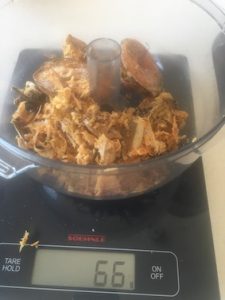

The resulting liquid was applied to each cell of seedlings, at about 1tsp/cell. The seedlings are delicate, and one broke while applying the spores. Counting the new arrivals, there are now 46 seedlings.
12 NOVEMBER 2017
A thin white “fuzz” has developed on the surface of many of the cells in the seedling tray. Perhaps this is the mycelium of porcini and saffron milkcaps germinating and searching for a host root system…or perhaps it is simply a mould growing on the rotting mushroom particles applied with the spore suspension…
4 DECEMBER 2017
Overnight, almost all seedlings have begun wilting. Most likely as a result of being kept in the seedling tray for too long and/or under watered
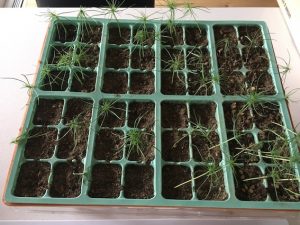
In an attempt to rescue as many plants as possible, they were repotted into individual pots for growing out. At the same time, additional spore suspension was created and mixed with the new potting medium (a commercial seedling & cutting mix by Amgro)
5 DECEMBER 2017
Those seedlings that could be saved have now been transplanted into the growing out pots. This process has damaged many of the seedlings, and it is not certain how many will have survived the process.
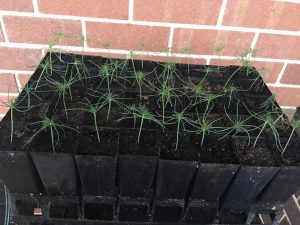
13 DECEMBER 2017
Many of the transplanted seedlings have now wilted, and will be removed
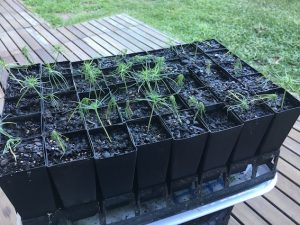
19 DECEMBER 2017
Remaining seedlings are looking healthy. Additional seeds have been planted in empty cells, although these are from a batch that had been heat treated overnight and are not expected to be viable. A few beech (Fagus sylvatica) seeds have been added to cells marked with single sticks. These were collected two years ago, and kept refrigerated. They are also not expected to be viable.
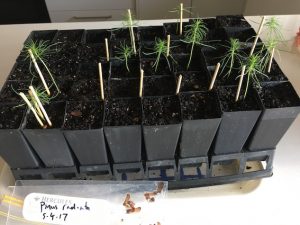
26 JANUARY 2018
The seedlings have continued growing. They are delicate, and additional short sticks have been added to help support them. None of the new Pinus or Fagus seeds have germinated.


wohh just what I was looking for, appreciate it for putting up.